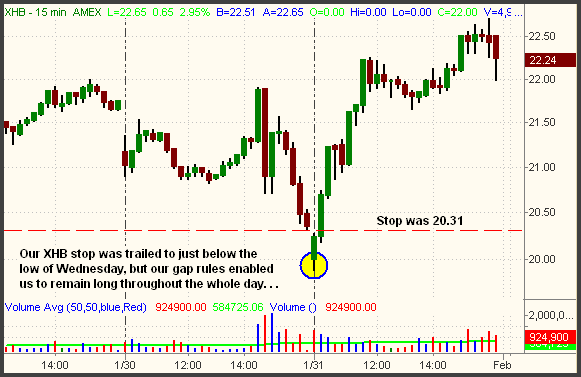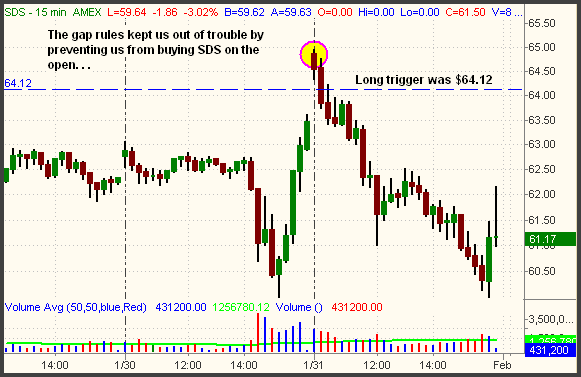My Rules for Daytrading Gap Opens
Due to large changes in overnight supply or demand, both the major market indices and individual stocks and ETFs will often open much higher or lower than where they closed the previous day, which is known as a “gap.” Buying or selling short a stock that hits its trigger price due to an opening gap is often riskier than entering a stock that trades through its trigger price in an orderly fashion, as the risk/reward ratio becomes negatively skewed. Likewise, open positions will sometimes gap open beyond their protective stop prices, but immediately reverse back in the right direction. The following details our personal trading rules for handling these tricky situations:
Stocks or ETFs that gap open beyond their trigger prices for entry: For a long setup, we only buy the stock or ETF if it subsequently sets a new high after the first 20 minutes of trading. For a short setup, we only sell short if the equity subsequently sets a new low after the first 20 minutes of trading. In both cases, the stock or ETF must exceed its 20-minute high (for longs) or 20-minute low (for shorts) by at least 10 cents before we will enter the position. Any opening gap of less than 10 cents above or below the trigger price will not prompt use of the gap rules.
Stocks or ETFs that gap open beyond their protective stop prices: If a long position gaps down to open at or below its stop price, we continue to hold the stock for the first 20 minutes of trading, at which point the new stop price is adjusted to 10 cents below the low of the first 20 minutes. For short positions, we adjust the stop to 10 cents above the high of the first 20 minutes.
One example of the gap rules occurred on January 31. Going into that morning, our stop in XHB had been trailed to a price of $20.31. Since XHB opened at $20, more than 10 cents below its stop, we automatically applied the MTG Opening Gap Rules to adjust our new stop to be 10 cents below the low of the first twenty minutes of trading. As you can see on the intraday chart below, XHB immediately reversed, never coming even close to breaking its twenty-minute low. We therefore remained in the position, which zoomed to a closing gain of more than 8%:

In the pre-market that same day, we were targeting a long entry in the inversely correlated UltraShort S&P 500 ProShares (SDS), but the gap rules saved us again. Our initial plan was to buy SDS above the January 30 high, so we had a trigger price for entry of $64.12. Since SDS gapped open at a price of $64.84, the gap rules applied, meaning we would now only buy SDS if it subsequently moved above the high of its first twenty minutes. This never happened, so we simply did not buy it. We’re pleased about that:

These are just two real examples of how our gap rules can be applied for both managing existing positions and pre-market setups for new trade entry. Obviously, the rules do not work 100% of the time, but they keep us out of trouble time and time again. A trade will sometimes need to be stopped out at a substantially lower price than if we simply closed it on the open. However, the number of times the rules have kept us in a winning trade (such as XHB) has more than made up for the additional losses we have realized when the 20-minute lows were broken and we stopped out lower. A bit of discretion is sometimes required as well, meaning we will occasionally close a position before its 20-minute low if it’s looking just plain horrible and doesn’t appear to just be a quick “shakeout.”
Deron Wagner is the head trader of Morpheus Capital Hedge Fund and founder of Morpheus Trading Group (morpheustrading.com), which he launched in 2001. Wagner appears on his best-selling video, Sector Trading Strategies (Marketplace Books, June 2002), and is co-author of both The Long-Term Day Trader (Career Press, April 2000) and The After-Hours Trader (McGraw Hill, August 2000). Past television appearances include CNBC, ABC, and Yahoo! FinanceVision. He is also a frequent guest speaker at various trading and financial conferences around the world. Wagner is currently working on this third book, scheduled for publication in early 2008.
For a free trial to the full version of The Wagner Daily above, which includes detailed ETF trade setups and daily position updates, or to learn about our other newsletters, visit morpheustrading.com or send an e-mail to deron@morpheustrading.com.
